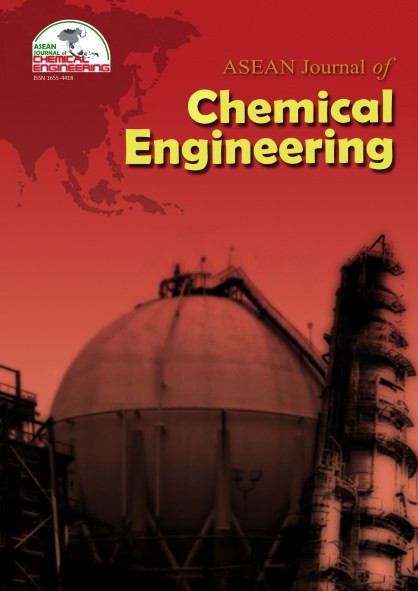Process Synthesis: design for Improved Effectiveness
Abstract
This paper sets out the motivation for using process synthesis techniques that have been developed over the past 25 years. These techniques enable developing countries to design processes that bypass the incremental improvement route. The most developed aspects of process synthesis will be discussed with particular focus on pinch technology. The technology gives emphases on both energy and capital cost targets for heat exchanger networks (HENs) and on the design techniques developed to meet these targets. A retrofit path can be identified and costed to improve on an existing process, and yield a design target to meet specified investment limits. These techniques have been applied for use in mass exchange networks (MENs), water optimization, hydrogen and oxygen usage, and production scheduling. One of the most significant developments in these areas has been the impact diagram, which shows reduction in environmental impact versus investment. Use of these techniques willlead to processes that are more effective in their use of resources and are, therefore, more sustainable.References
El-Halwagi, M. M., and Manousiouthakis, V. (1989). "Synthesis of mass exchange networks,” AIChe J., 35, 8, 1233–44.
El-Halwagi, M, M., and Manousiouthakis, V. (1990). "Automatic synthesis of mass exchange networks with single component targets," Chem. Eng. Sci., 45, 9, 2813-31.
Douglas, J. M. (1988). Conceptual design of chemical processes, McGraw-Hill, New York.
Douglas, J. M. (1992). "Process synthesis for waste minimisation," Ind. Eng. Chem. Res., 31, 238 43.
Fraser, D. M., and Gillespie, N. E. (1992). "The application of pinch technology to retrofit energy integration of an entire oil Process Synthesis 63 refinery," Trans I Chem E, 70, Part A, 395–406.
Fraser. D. M., and Hallale, N. (2000a). “Retrofit of mass exchange networks using pinch technology," AICHEJ, 46, 10, 2112–7.
Fraser, D. M, and Hallale, N. (2000b). “Determination of effluent reduction and capital cost targets through pinch technology," Environmental Science and Technology, 34, 19, 4146–51.
Fraser, D. M., Howe, A., Hugo, M., and Msiza, A. K. (2001), Retrofit of mass exchange networks to meet cost and pollution reduction criteria, 6th World Congress of Chemical Engineering, Melbourne, Australia.
Fraser, D. M., Hallale, N., Harding, N., Matthews, C., Jacobson, P., and Sibulela, S. (2001). Systematic techniques for synthesis of optimum mass exchange networks, 6th World Congress of Chemical Engineering, Melbourne, Australia.
Hallale, N., and Fraser, D. M. (1998a). "Capital cost targets for mass exchange networks. A special case: Waste minimisation," Chem. Eng. Sc., 53, 2, 293–13.
Hallale, N., and Fraser, D.M. (1998). "Synthesis of a costoOptimum gas-treating process using pinch analysis,” Advances in Environmental Research, 2, 2, 167–78.
Hallale, N., and Fraser D. M. (2000a). "Capital cost targets for mass exchange networks," Parts I–II, Computers and Chemical Engineering, 53, 2, 293-313.
Hallale, N., and Fraser D. M. (2000b). "Supertargeting for mass exchange networks," Parts 1–11. Trans I Chem E, 78, Part A, 202–16.
Linnhoff, B. (1993). "Pinch analysis: A state-of the-art overview," Part A, Trans. IChemE, 71, 503-22
Linnhoff, B., and Flower, J. R. (1978). "Synthesis of heat exchanger networks," AICHE J., 24. 4, 633–54.
Linnhoff, B., Townsend, D. W., Boland, D., Hewitt, G. ., Thomas, B. E, A., Guy, A. R., and Marshland, R. H. (1982). "User guide on process integration for the efficient use of energy," IChemE, Rugby, U. K.
Papalexandri, K. P., Pistikopoulos, E. N., and Floudas, C. A. (1994). "Mass exchange networks for waste minimization: A simultaneous approach," Part A, Trans IChemE, 72, 279-94.
Ponton, J. W., and Donaldson, R. A B. (1974). "A fast method for the synthesis of optimal heat exchanger networks," Chem. Eng. Sci., 29, 2375-77.
Rudd, D. F., Powers, G. J., and Siirola, J. J. (1973). Process synthesis, Prentice-Hall, Englewood Cliffs, New Jersey.
Seider, W. D., Seader, J. D., and Lewin, D. R. (1999). Process design principles: Synthesis, analysis, and evaluation, Wiley, New York.
Shenoy, U, V. (1995). Heat exchanger network synthesis: Process optimization by energy and resource analysis, Gulf Publishing Company, Houston, Texas.
Smith, R. (1995). Chemical process design, McGraw-Hill, New York. Tjoe, T. N., and Linnhoff, B. (1986). "Using pinch technology for process retrofit," Chem. Eng., 93, 8, 47-60.
Turton, R., Bailie, R. C., Whiting, W. B., and Shaewitz, J. A. (1998). Analysis, synthesis and design of chemical processes, Prentice-Hall, Upper Saddle River, New Jersey.
Wang, Y., and Smith, R. (1994). “Wastewater Minimisation," Chem. Eng. Sci., 49, 981– 1006.
Copyright holder for articles is ASEAN Journal of Chemical Engineering. Articles published in ASEAN J. Chem. Eng. are distributed under a Creative Commons Attribution-NonCommercial 4.0 International (CC BY-NC 4.0) license.
Authors agree to transfer all copyright rights in and to the above work to the ASEAN Journal of Chemical Engineering Editorial Board so that the Editorial Board shall have the right to publish the work for non-profit use in any media or form. In return, authors retain: (1) all proprietary rights other than copyright; (2) re-use of all or part of the above paper in their other work; (3) right to reproduce or authorize others to reproduce the above paper for authors’ personal use or for company use if the source and the journal copyright notice is indicated, and if the reproduction is not made for the purpose of sale.



